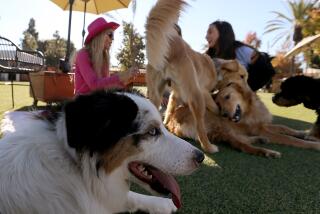Fitness Is the Key to Those Animal High Spirits
- Share via
Stephanie and Mark Roebber want to raise 6-year-old Killian the right way. They take him to a play group in the morning and toss the Frisbee around in the evening. He expends his youthful energy outdoors and seems much calmer at home than his peers.
Killian, an Australian shepherd, is a pampered pup--and a healthy one too, thanks to a good diet and plenty of exercise with his owners. Like the Roebbers, 68% of pet owners provide their pets with regular exercise, according to a 1999 survey by the American Animal Hospital Assn.
Still, about 60% of all adult dogs nationwide are overweight or likely to get that way, according to another AAHA survey. To keep your pet healthy and to help maintain the proper weight, veterinarians recommend something many humans could use more of as well: exercise.
Not all pet owners realize that pets need exercise, Stephanie Roebber says.
“It’s different from taking the puppy once around the block and putting it in a crate,” she adds. “They enjoy exercise, and all those things play toward health, physically and mentally.”
Dr. Mark Olcott of the Germantown (Md.) Veterinary Clinic says that “a lot of [behavior] problems--destroying your house, dragging people on the leash, being hyper--can be improved by just more exercise.”
If your pet is a couch potato, start slowly, with about 15 minutes of play a day, and work your way up, suggests Dr. John Fioramonti, a veterinarian at the Towson (Md.) Veterinary Hospital. Beyond the bathroom walk around the block, dogs can chase balls and swim. Cat owners can tempt their pets with a toy called a buggy whip, a tassel tied to a stick, or a ball specially weighted to roll on its own.
Towson resident Patty Hunt teases her cat Mabry with a laser pointer. Mabry chases the red dot around the room and tries to dig under doors when Hunt points the light beneath them.
Virginia Poole and her beagle, Brazil, love to run. Bred for helping hunters, Brazil will chase anything that moves. So Poole runs with the dog while her boyfriend runs about 30 feet ahead.
“She’ll run forever chasing the equivalent of a fox or a bunny,” says Poole, who lives in Washington, D.C.
Exercising with a pet can become a comfortable routine that lasts for years. Stephanie Roebber has walked and played ball with Killian every morning since he was a puppy.
For about an hour before heading to work, the Parkville, Md., resident joins a few neighborhood pet owners on weekday mornings--and nearly a dozen on weekends--to exercise at local parks so they don’t wake the neighbors’ dogs. Sometimes they swim in the Chesapeake Bay or play soccer.
Exercising with a pet can also keep owners healthy as they age. “One of the most valuable reasons for the elderly to own a pet is the responsibility they have to do the same things for the dog they need to be doing for themselves,” Fioramonti says. “They exercise themselves, and they get out and say hi to people. Owners get the same type of benefits their pet gets.”
Understanding the nature of the pet’s breed can help owners decide on a course of exercise. Many retrievers, for example, enjoy swimming and playing fetch. Herding dogs such as collies may prefer agility courses.
While it’s OK to try different activities with dogs to see what they enjoy, owners should be careful not to overdo it.
“Often dogs get so excited they don’t know when to stop themselves,” Olcott says. “They literally run till they drop.”
Touch the dog to see if it is too hot, and watch out for heavy panting. Dogs do not sweat; they release heat by panting. Long-haired dogs are more susceptible to overheating. Take plenty of breaks, and make sure the dog has enough water. And never tie a dog’s leash to a bike or a car.
More to Read
Sign up for Essential California
The most important California stories and recommendations in your inbox every morning.
You may occasionally receive promotional content from the Los Angeles Times.













